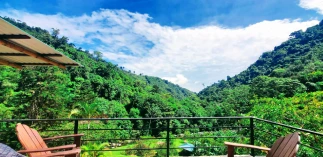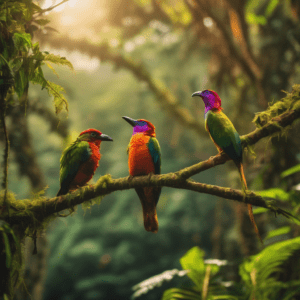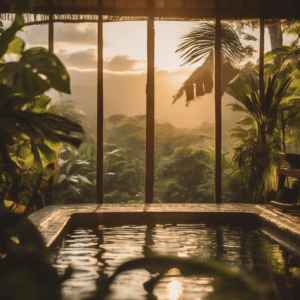There’s a quiet side to Costa Rica that lies far beyond the well-trodden paths of its beaches and volcanoes—a realm where nature rules and silence speaks louder than sound. Staying in a jungle lodge in Costa Rica experience means giving yourself over to that rhythm: a stay where the rainforest itself becomes both roof and companion. Yet, while many travelers chase the familiar names, a handful of hidden jungle retreats remain untouched by the crowds—intimate sanctuaries where the wild still breathes freely, and human presence feels almost incidental.
These lodges aren’t built to impress with extravagance but to blend seamlessly into the land. They whisper, rather than shout. They invite guests to be still, to listen, and to remember that luxury can exist in simplicity.
The Allure of Seclusion
Hidden jungle lodges appeal to a rare kind of traveler—someone drawn to silence, connection, and the mystery of the untamed. These are places you reach not by schedule but by surrender. Roads may end before you arrive, rivers might become your only path, and the forest will slowly envelop you.
There is a profound comfort in that distance. Away from noise and artificial light, life begins to unfold at nature’s pace. The forest hums its evening lullaby, mornings shimmer with mist, and nights glow faintly under a sky unspoiled by modernity.
What Defines a Hidden Jungle Lodge?
While Costa Rica offers hundreds of eco-lodges and nature retreats, the truly hidden ones share a few defining traits. They don’t advertise loudly or stand near main highways. Their architecture is humble, designed to vanish into the forest. They prioritize experience over convenience and reflection over entertainment.
A few hallmarks of hidden jungle lodges include:
- Remote location: Deep within national parks or private reserves.
- Minimal human footprint: Construction that respects local ecology.
- Off-grid energy: Solar or hydro power instead of city electricity.
- Intimate capacity: Few rooms, often fewer than ten.
- Community involvement: Supporting nearby families and conservation efforts.
These places exist as quiet promises of what travel can be when it’s stripped of excess.
Entering the Realm of Green
Arriving at a hidden jungle lodge feels like stepping through a threshold. The air thickens, rich with the scent of rain and orchids. The forest hums in unison—monkeys in the canopy, frogs below, birds flashing color between branches.
It’s not about amenities or schedules anymore. You unpack slowly, breathe deeply, and start noticing the details: how the leaves catch sunlight, how silence shifts tone between dawn and dusk. Every sense sharpens, and every movement feels deliberate.
This is immersion, not tourism. You are no longer passing through nature—you are held within it.
The Philosophy Behind the Hidden
The concept of a hidden lodge in Costa Rica is not about secrecy—it’s about preservation. The remoteness serves a purpose: to protect fragile ecosystems from overexposure and to allow guests a chance to experience nature without intrusion.
The best of these lodges function as extensions of the landscape. They use fallen timber, harvest rainwater, and compost everything they can. Even the lighting is subdued—soft bulbs or lanterns that don’t disturb nocturnal life.
Staying there becomes an act of quiet participation in something ancient and sacred—the ongoing balance between wilderness and respect.
The Soundtrack of Solitude
Silence in the jungle is never empty. It’s alive, textured, and rhythmic. Mornings begin with bird calls cascading from treetops—parrots, tanagers, and toucans competing for the sun’s first rays. Afternoon rain strikes leaves in percussive patterns. At night, cicadas rise in chorus while the river whispers its steady tune.
Every sound tells a story, and every pause between them offers space to think, to breathe, or simply to feel small beneath something infinite.
Hidden Gems Among the Green
These secret lodges are scattered across Costa Rica’s varied landscapes—each offering a distinct kind of intimacy with nature. Some rest along riverbanks cloaked in mist, while others cling to the edge of mountain slopes, catching clouds as they pass.
Some remarkable locations where hidden jungle lodges thrive include:
- Osa Peninsula: Where rainforest meets the Pacific and scarlet macaws rule the skies.
- Bajos del Toro: Home to waterfalls that carve the mountains like ribbons of turquoise.
- Talamanca Mountains: Remote and spiritual, where Indigenous culture and forest coexist.
- Sarapiquí Region: Lush lowlands alive with biodiversity and quiet waterways.
- Caribbean Foothills: Rich with dense foliage and a slower, humid rhythm.
Each region offers solitude not as absence but as abundance—the luxury of space, air, and stillness.
The Art of Minimalism
Hidden jungle lodges celebrate restraint. Rooms are simple, often open-air, with furniture crafted by local artisans. Beds are draped in mosquito nets that catch the morning light. There’s no air conditioning because the forest provides its own cool.
Electricity may flicker with the rhythm of the sun, and that’s part of the charm. Without constant access to screens, time stretches. Meals are shared with others or eaten in silence to the chorus of frogs.
This minimalism isn’t deprivation—it’s freedom.
Food as Connection
Dining in a hidden jungle lodge is less about indulgence and more about communion. Meals are typically prepared with ingredients grown or gathered nearby—plantains, cassava, cacao, and tropical fruits bursting with flavor.
Every dish carries a sense of place. You taste the rain in the greens, the sun in the fruit, and the soil in the herbs. Cooking methods are often traditional, wood-fired, and slow, reflecting patience and respect for ingredients.
Eating here becomes both nourishment and ritual.
The Night the Forest Comes Alive
Once the sun dips behind the canopy, the jungle transforms. Fireflies flicker like drifting stars, and the air hums with nocturnal life. The darkness feels complete, pressing gently on your senses.
Stepping outside your room becomes an act of courage and wonder. You move slowly, guided by moonlight or a dim lantern. Somewhere nearby, a frog croaks, a branch snaps, and a breeze stirs leaves like soft applause.
This night is not empty—it’s intimate. It reminds you that the forest never sleeps.
Encounters Beyond Expectation
The magic of these lodges lies in their unpredictability. One morning, you might wake to a troupe of howler monkeys greeting the dawn. Another day, you may find a blue morpho butterfly resting on your windowsill.
Every visit carries moments of unplanned connection—nature choosing to meet you, not the other way around.
The creatures here are not performers; they are residents. You are the visitor, and the privilege of presence is your ticket.
Human Touch, Natural Heart
Hidden doesn’t mean isolated from humanity—it often means more connected to it. Many jungle lodges are sustained by local families who act as caretakers rather than hosts. Their knowledge of the forest runs deep, inherited through generations.
Conversations over shared meals often touch on rain cycles, medicinal plants, and the rhythms of wildlife. These exchanges enrich the stay, reminding you that nature and culture are never separate—they breathe through each other.
Sustainability Beyond Buzzwords
For hidden jungle lodges, sustainability isn’t a feature—it’s the foundation. The remoteness demands responsibility. Every decision, from architecture to waste management, carries ecological weight.
Typical sustainable practices include:
- Using solar panels for energy.
- Capturing and purifying rainwater.
- Composting organic waste and recycling materials.
- Maintaining reforestation programs.
- Limiting guest numbers to protect local ecosystems.
Such actions are quiet, consistent, and essential. They ensure that the experience remains as pure decades from now as it is today.
Where Time Slows and Stillness Teaches?
Hidden jungle lodges create an atmosphere where time loosens its grip. The forest’s rhythm replaces the clock’s insistence. You wake when light filters through leaves and rest when darkness deepens.
This shift fosters awareness. You notice small miracles—a hummingbird pausing mid-air, raindrops forming constellations on your arm, or the scent of wet bark after a storm.
In stillness, gratitude grows.
A Refuge for the Spirit
Life surrounded by constant motion can dull the senses. Hidden lodges act as antidotes to that pace, providing not entertainment but renewal. Here, simplicity replaces stimulation, and silence becomes a teacher.
Guests often describe the experience as restorative—a mental and emotional detox from urban complexity. The forest doesn’t ask for effort; it asks for attention.
Even those accustomed to noise find peace in surrendering to quiet.
Design That Disappears
Architecturally, these lodges are love letters to the landscape. Roofs mimic the slope of surrounding hills. Wood blends seamlessly with trunks. Walls, when they exist, are often partial—allowing light and breeze to pass unimpeded.
Paths between rooms twist organically through the forest rather than cutting straight lines. Each decision honors the terrain’s natural story, leaving minimal scars upon it.
The beauty here lies in invisibility.
The Journey Within the Journey
Reaching a hidden jungle lodge is often an adventure of its own. Dirt roads, river crossings, and long walks under canopies of green replace highways and airports.
The journey itself becomes an initiation—by the time you arrive, the outer world feels distant, almost forgotten. You’ve already slowed down. You’ve already begun to listen.
This sense of arrival without haste defines the essence of true travel.
Lessons the Jungle Teaches
Every guest leaves with something intangible—an insight carried quietly back to ordinary life.
Common reflections shared by travelers include:
- Appreciation for simplicity over excess.
- Respect for nature’s patience and precision.
- Awareness of the interconnection between all living things.
- A desire to tread more lightly on the planet.
The forest teaches without words, revealing truths that linger long after departure.
The Romance of Isolation
There’s something inherently romantic about seclusion—the shared silence, the flicker of candlelight against wood, the rain echoing softly through the night. Hidden jungle lodges invite intimacy, not just between people, but between humans and the natural world.
You wake with the dawn, walk barefoot on cool stone, and bathe under open skies. Life reduces to essentials, and every gesture feels meaningful.
This quiet intimacy is what draws many to return—seeking again that balance between love and wilderness.
When the Rain Speaks
Costa Rica’s tropical rains are part of the experience, not an interruption. When storms move through, they bring renewal. You listen from your veranda as the sound rises and falls like breath—steady, cleansing, and alive.
The rain strips away pretense. It invites reflection, urging you to pause, to watch, to simply exist in the rhythm of falling water.
Many guests find their most profound memories not in sunshine but in those grey, glistening moments when nature feels closest.
Beyond Tourism—Toward Belonging
Staying in a hidden lodge shifts perception from tourism to participation. You stop consuming experiences and start coexisting with them.
The forest ceases to be a spectacle and becomes a relationship—one built on awareness, humility, and gratitude. You begin to sense that every action, no matter how small, ripples through the ecosystem.
This realization often transforms how travelers live afterward—choosing mindfulness over convenience, and connection over control.
The Gift of Leaving
Departure from a hidden jungle lodge carries a peculiar ache. You pack slowly, reluctant to fold away the rhythm that has reshaped you. The forest’s pulse still hums faintly in your veins.
As you leave, monkeys call from the canopy as if to remind you—you’ve been part of something larger, even if only for a moment.
That’s the true essence of the experience: not ownership, but belonging; not escape, but return.
A Whisper That Stays
Long after returning home, the jungle stays with you. In quiet moments, you’ll hear echoes of rain, remember the scent of damp earth, and feel the calm of green light filtering through trees.
Hidden lodges don’t just offer a stay—they offer perspective. They remind you of the elegance of restraint, the grace of stillness, and the rare beauty of existing quietly within something vast and alive.
And perhaps, that whisper is what draws people back to Costa Rica’s hidden heart—time and again, to listen once more.







